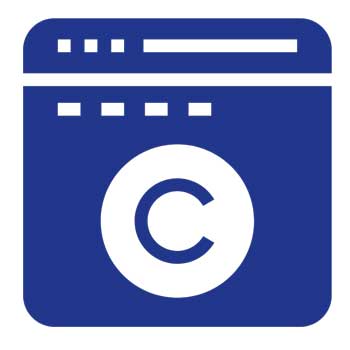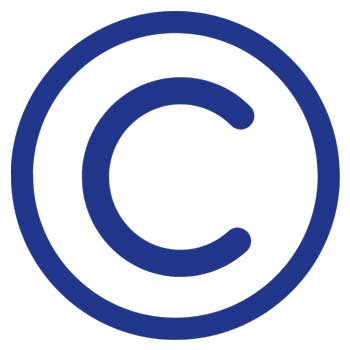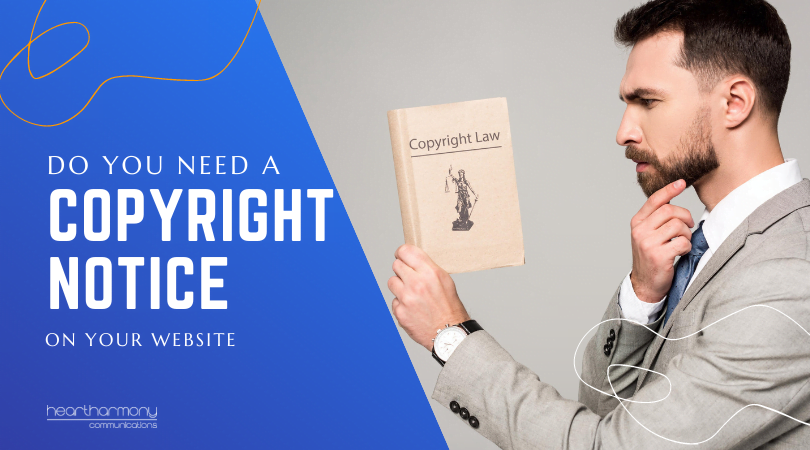What is a copyright notice & why do you need one on your Australian small business website? A quick review of the legals and what you need to know to correctly include a website copyright notice.
At the beginning of each year, one of the regular website tasks is to update your copyright notice in your footer. But what is a copyright notice, and why do you need one on your small business website?
Websites & Copyright Law in Australia
I need to kick this off by stating I am not a lawyer, so this is not legal advice, but my best understanding of Australian copyright law and website best practice.
Copyright is a type of intellectual property law. It is different from copywriting, which is when someone writes an article or other text. (For example, we do website copywriting where we the write the words for our client’s websites.)
Copyright helps to protect the creators of original content and to determine how their work can be used.
It covers things and materials such as words, source code, illustrations, and other images, but not ideas, styles, techniques, names, or slogans.
If you want to protect your logo, slogan, etc., you need to talk with your lawyer about trademarking (which is a different legal thing to copyright).
Australia has very generous copyright law. Copyright is free and automatic and starts from the moment you create something in “material form”.
You don’t need to pay anyone, talk with a lawyer, fill in a form or register anything in Australia for the copyright to apply.
As long as the work is an original work created by an Australian citizen, resident or protected person, copyright automatically happens as soon as you create it and save it to disc, hard drive, cloud, etc.
In Australia, a whole website is not protected by copyright. However, its component parts (text, blog posts, photos, illustrations, videos, podcasts, etc.) are each protected by their own individual copyright.
In other words, the misconception that anything that is on the internet is copyright-free and available to be copied is wrong.
(For a detailed explanation of what is OK and not OK in terms of website copyright check out the publication “Websites and Copyright” by the Australian Copyright Council).

Who Owns the Copyright?
Australia’s Copyright Act sets out the rules around copyright. In general, the person who created the thing or the material owns the copyright unless they agree otherwise.
Some key exemptions apply. Where the work is made by an employee (and not a freelancer or someone you have hired to do the work), the employer owns the copyright.
For work done by freelancers or if you have paid someone for the work to be done, the creator owns the copyright, and you can only use the material for the purposes for which it was commissioned unless they transfer the full copyright to you.
This means that while you may have paid for the website or the work to be done, you may not own the copyright to it.
If you have a web designer or web copywriter help you to create your website for you, remember to have a clear agreement about copyright, and if and when it is transferred over to you.
For example, we have a clause in all our website contracts that says that we are the copyright owners for the work, but that we automatically transfer full copyright to our clients on payment in full of the final invoice of the agreed contract.
Many other web designers don’t do that, which means they are within their legal rights to stop you changing anything on your website, moving your website away from them or they can charge you more if you want copyright assigned to you.
Creators of copyright material have the following rights:
- to be attributed when their work is used;
- not to have their work falsely attributed to someone else, nor to have the altered work attributed as if it were unaltered; and
- not to have the work treated in a manner that would prejudice the creator’s honour or reputation.
Copyright protection gives the copyright owner a legal basis for taking action if their copyright is infringed. However, it is up to the copyright owner to identify infringements and act. There is no organisation set up to investigate or prosecute infringements on behalf of copyright owners in Australia.
Do You Need a Website Copyright Notice on Your Website?
One way you can help make it less appealing for people to liberate your website content is to add a copyright notice to your website.
Copyright notices are not a legal requirement to assert your copyright rights in Australia, but merely help make it clear that you own the rights to your content and act as a deterrent.
Some people wrongly assume that if they can’t see the notice, the material is not covered and merrily download your content without knowing it is illegal. Adding a copyright statement helps stop these people from inadvertently breaking the law.
Where Should You Put the Copyright Notice on a Website?
As people can land on different pages of your website depending on the results they search for in search engines, you want the notice to be visible on every page, which is why most web designers include it in the footer of a website.

What Is the Correct Format of Website Copyright Notice?
A copyright notice has three parts to it (e.g., © 2021 Heart Harmony Communications).
1) The copyright symbol © and/or the word “Copyright”. You can use one or the other or both if you prefer. This bit goes first in your website copyright notice.
2) The name of the copyright owner (e.g., Heart Harmony Communications).
For individuals, you can use your “pen name” or pseudonym, but it is better if you can use your real name as it makes it easier to identify who owns the copyright if people want to use your work.
For businesses, you can use the trading name or the registered company name. To be strictly legally correct, you should use the registered company name as business trading names are not legal entities that can own property (and copyright is a form of intellectual property). That said, your notice is not invalid if you just use your trading name.
3) The year the work was published. This is tricky for websites which are updated regularly (each plugin update means the site has been republished). In Australia, you can either use the current year or the year the work was first published, followed by the current year. (e.g., © 2016-2020 Heart Harmony Communications).
Either option is legally OK, and often it is more a matter of preference as to how you wish to present your year in your website copyright notice.
That said, if your site shows © 2014, there is a perception that you are out of date, don’t care about your website and could be untrustworthy. Always include the most current year (even if you have to set the code to auto-update it for you).
(If you use Divi as your website theme, this post by Pee Aye Creative will help you set up an auto-updating footer in your Divi site.)
Many businesses expand this copyright statement in their Website Terms by outlining what images/text/downloadable materials can be downloaded and reproduced from their website, and by whom.
Website Terms are generally different to your Privacy Policy – which is another legalities all Australian websites need to consider.
The types of limitations you place in your website terms are something you need to discuss with your lawyer to ensure they accurately reflect what rights you are willing to assign to others who access your website.
If your site does not have terms and conditions, then people can only use the material as permitted under the Copyright Act.
What if Someone Copies All or Part of Your Website?
If someone copies all or part of your website, they are in breach of Australian Copyright laws. Talk with your lawyer for legal advice on what formal action you can take.
You can also contact the website owner via email or in registered post letter, highlighting the bits that have been “liberated” and asking them to immediately (e.g., within 48 hours) remove the offending images/text/pages from their website.
You can also include a request for compensation or payment of a licensing fee if appropriate and indicate any further action you will take if your request is not complied with.
If they do not respond within your timeframes, and if they are substantially copying your site’s content, you can approach their hosting provider to remove the site for breach of copyright.
You can also report the matter to Google to have it removed from the search index for breach of copyright.
Last Thoughts
While your website does not legally need a website copyright notice to be protected under Australian copyright law, it helps to assert your rights and deter inadvertent rule breakers.
If you do include a copyright statement in your website, remember to update it each year to remain current and to deter would-be content stealers.





